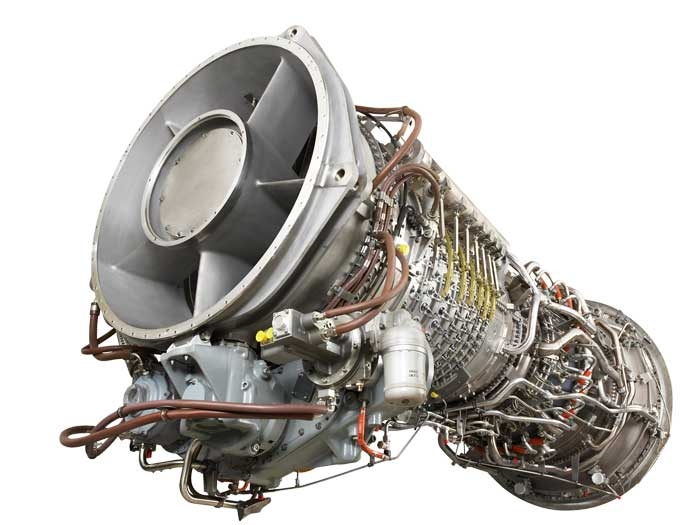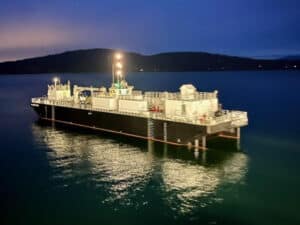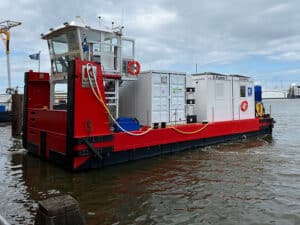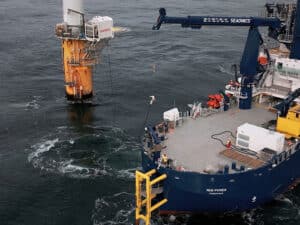
GE and LR look for gas turbine commercial ship opportunities
Written by Nick Blenkey
30 MW GE marine gas turbine
JULY 23, 2014 — Could the move to LNG fueling present new opportunities for gas turbine powering of commercial ships?
GE Marine and Lloyd’s Register report they have just signed a Memorandum of Understanding (MOU) to identify potential gas turbine-powered commercial ship projects. The news follows an earlier, separate, announcement reporting that GE Marine, Dalian Shipbuilding Industry Company (DSIC) and Lloyd’s Register have jointly developed a design for a gas turbine-powered LNG carrier that, they say, will provide low life cycle cost, high environmental performance and flexible design.
The initial LNG carrier design will be built around a GE gas turbine-based COmbined Gas turbine Electric and Steam system (COGES) that will feature one 30-megawatt gas turbine, one steam turbine generator-set and two dual-fuel diesel generator-sets for low power operation and backup. However, the carrier will allow for flexible configuration of prime movers, offering total installed power of more than 50 MW, if required. Approval in Principle for the COGES arrangement is expected shortly.
Brien Bolsinger, Vice President, Marine Operations, GE Marine, says that through the MOU announced today “we will identify target segments and commercial customers for our highly-efficient marine gas turbine systems.”
“GE already has an established base of 90 marine gas turbines operating on 17 cruise ships, five high speed yachts and 19 fast ferries,” he adds.
GE gas turbine systems offer power density (i.e., high power in a light weight, small footprint), fuel flexibility, and an optional, highly reliable Dry Low NOx emissions (DLE) combustion system technology. GE’s DLE combustion system can meet Tier III IMO/Tier IV United States Environmental Protection Agency requirements now with no exhaust treatment when operating on natural gas or on liquid fuels in combined cycle.
“GE’s industrial LM2500 family fleet has logged nearly 70 million hours operating on natural gas, of which 20 million hours were dual fuel applications,” says Mr. Bolsinger. “In addition, the 585 industrial applications that use our DLE combustion system have logged more than 12 million hours. Separately land-based operators report a 99.9% reliability rate across our gas turbine fleet.”
“This MOU will allow us to work with some of the leading shipyards to approve in principle GE gas turbine-powered commercial vessels for global customers,” said Nick Brown, Marine Chief Operating Officer, Lloyd’s Register. “We can assist shipping industry stakeholders with understanding how the technical performance of these gas turbines can help meet commercial requirements. We always welcome shipowners and operators who would like to participate in joint development projects involving new applications.”
This MOU is separate of an announcement made in December 2013, whereby GE Marine, Dalian Shipbuilding Industry Company (DSIC) and Lloyd’s Register have jointly developed a design for a gas turbine-powered LNG carrier. This carrier will provide low life cycle cost, high environmental performance and flexible design.
The initial LNG carrier design will be built around a GE gas turbine-based COmbined Gas turbine Electric and Steam system (COGES) that will feature one 30-megawatt gas turbine, one steam turbine generator-set and two dual-fuel diesel generator-sets for low power operation and backup. However, the carrier will allow for flexible configuration of prime movers, offering total installed power of more than 50 MW, if required. Approval in Principle for the COGES arrangement is expected shortly.
Benefits of Gas Turbines
In addition to lower emissions, claimed benefits of gas turbines for commercial ship applications include:
- Power density: A gas turbine-based system versus a medium speed diesel system produces the same power; however, the gas turbine system is 40% lighter with a 60% smaller footprint. Gas turbine propulsion arrangements onboard a ship require reduced structural steel to support the system within and frees up more revenue generating payload space. A perfect example of this benefit is on a cruise ship, where the gas turbines are placed inside the exhaust stacks at the top of the ship, opening up space for an additional 45 state rooms in the hull below.
- Fuels flexibility: GE gas turbines operate on a variety of fuels, including MGO, biodiesel, bio-synthetic paraffinic kerosene blends and natural gas. Dual fuel gas turbines operate in gas fuel mode (without liquid pilot flow), or liquid fuel mode, and change between modes within 30 seconds. Fuel flexibility is even more beneficial today as commercial ship operators adopt dual-fuel operating scenarios to meet new emissions regulations. Gas turbines can respond to rapidly changing load demands.
- Reduced maintenance costs: Gas turbines follow an “on condition” maintenance philosophy. This means that engine overhaul is not rigidly scheduled, but is based on findings at regularly scheduled inspections or during downtime in ship schedules, such as dry dock. Even while operating at full power, 100% of the time, combustor and hot section repair intervals are anticipated at 25,000 hours when operating on natural gas fuel. Customized maintenance services for gas turbines are offered through both GE as well as the company’s global network of authorized service providers.
- Increased availability: GE gas turbines offer easy maintenance and scheduled inspections. When engine overhaul is required, the gas turbine is quickly removed and replaced by a spare unit. Overhaul is not performed in-place (on-ship), but under shop conditions at a land-based depot facility. This approach ensures the highest quality service and highest availability for the ship, since full power is always available from the installed engines.
- Reliability: Built incorporating the latest aircraft engine design technologies, quality requirements and corrosion resistant materials, each GE gas turbine provides 99.9% reliability, along with outstanding performance.





Leave a Reply
You must be logged in to post a comment.